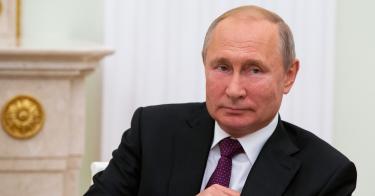In March 2018, Russian President Vladimir Putin announced the development of a whole new line of "invincible" strategic nuclear weapons, including a new ICBM, a nuclear-powered cruise missile, a plane-launched hypersonic missile and an underwater nuclear drone ominously called the "Poseidon."
At the time, the world wasn't sure what to make of this announcement. Was Putin serious? Now, though, all doubt has ended: On Aug. 8, Russia's new cruise missile apparently blew up in testing, killing at least seven people.
At the same time Russia was covering up this accident, 18 Democratic senators were sending a letter to the leadership of the Senate Armed Services Committee asking for their support to deny the administration's request to deploy a few low-yield nuclear weapons on submarines and, instead, to trust in nuclear arms-control agreements to protect America.
Former Defense Secretary James Mattis' 2018 Nuclear Posture Review recommended a few modest steps to improve the nation's deterrent posture, including the modification of a small number of submarine-launched ballistic missiles to carry a lower-yield warhead. This move fills a deterrent gap with Russia that has steadily increased over the years.
As retired nuclear expert Frank Miller has explained, Russia doctrine emphasizes the use of lower-yield nuclear weapons. They have retained tactical nuclear weapons they promised to destroy, and unlike the U.S., routinely exercise the use of these weapons. Without such a capability, the U.S. lacks a credible means to deter the use of such weapons.
The senators state the proposed low-yield warhead is a "dangerous, costly, unnecessary and redundant addition to the U.S. nuclear arsenal" and ask for funding to be denied. The facts are different. The warhead is safe, essentially paid for already and desperately needed.
Russia has at least a 10 to 1 advantage in the number of low-yield nuclear weapons over the U.S. A lack of a U.S. response to the Russian's asymmetric advantage is the danger we need to worry about.
The senators also argue that placing a low-yield nuclear weapon on our ballistic-missile submarines might compromise that important asset. Such an argument betrays a lack of understanding of the difficulty targeting U.S. submarines in the open ocean, even one that recently launched a missile.
They also contend the use of a low-yield nuclear warhead on a sub-launched missile might provoke Russia into a large-scale nuclear exchange, since they couldn't be certain what type of warhead was on the missile until it landed. This is a specious argument; both U.S. and Russian nuclear planning is crafted to be proportional and discrete.
The senators bemoan the demise of the Intermediate-Range Nuclear Forces Treaty. They suggest the administration undertake "pragmatic and strategic planning steps" as our sole response. We now know that for at least five years Russia has been willfully violating the INF Treaty with the development and deployment of the SSC-8 nuclear-capable cruise missile. Although acknowledging this, the senators propose to deny all funding for the U.S. to pursue a modest counter to Russia's treaty-violating class of missiles because it could "contribute to a renewed arms race or drive a wedge in our existing alliances."
Make no mistake, there's definitely a nuclear arms race underway. But Russia started the race two decades ago, while the U.S. has yet to leave the starting blocks. This group of senators would like to pretend otherwise. Our allies, though, have steadfastly supported the U.S. decision to withdraw from the INF treaty.
More fundamentally, over the last 20 years, Russia has embarked upon and largely concluded a broad modernization of its entire nuclear-weapons program, deploying all new weapons and launchers. Every leg of the Russian nuclear triad of bombers, sea-based missiles and ICBMs has been upgraded.
In contrast to Russia's nuclear modernization efforts, the United States has experienced the profound effects of age and underfunding on our nuclear deterrent. The U.S. nuclear triad was largely deployed in the 1980s or earlier (40 years ago) and, while well maintained, now must be modernized or risk obsolescence. No new platforms or weapons have been developed or designed in the decades since.
Fortunately the leadership of Senate Armed Services Committee and the Senate as a whole has already adopted a more sensible view of the world - the world as it exists today, not as we would prefer it. In their version of the National Defense Authorization Act, they authorized the funding for the deployment of the low-yield nuclear weapon, as well as a modest amount of money to pursue options to respond Russian violation of the INF treaty. Hopefully Congress as a whole acts in the best interest of U.S. national security.
It seems Putin is deadly serious. Are we?
This piece originally appeared in The Independent Record



